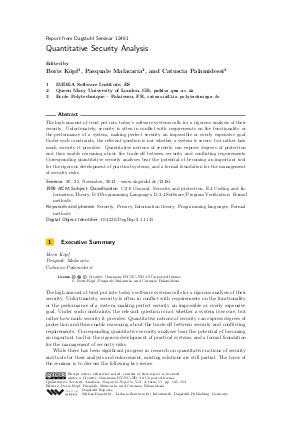Quantitative Security Analysis (Dagstuhl Seminar 12481)
Authors Boris Köpf, Paquale Malacaria, Catuscia Palamidessi and all authors of the abstracts in this report
-
Part of:
Issue:
Dagstuhl Reports, Volume 2, Issue 11
Part of: Volume: Dagstuhl Reports, Volume 2
Part of: Journal: Dagstuhl Reports (DagRep) - License:
 Creative Commons Attribution-NonCommercial-NoDerivs 3.0 Unported license
Creative Commons Attribution-NonCommercial-NoDerivs 3.0 Unported license
- Publication Date: 2013-03-25
File

PDF
DagRep.2.11.135.pdf
- Filesize: 0.81 MB
- 20 pages
Document Identifiers
Subject Classification
Keywords
- Security
- Privacy,Information theory
- Programming languages
- Formal methods
Metrics
- Access Statistics
-
Total Accesses (updated on a weekly basis)
0Document
0Metadata
Abstract
The high amount of trust put into today's software systems calls for a rigorous analysis of their security. Unfortunately, security is often in conflict with requirements on the functionality or the performance of a system, making perfect security an impossible or overly expensive goal. Under such constraints, the relevant question is not whether a system is secure, but rather how much security it provides. Quantitative notions of security can express degrees of protection and thus enable reasoning about the trade-off between security and conflicting requirements. Corresponding quantitative security analyses bear the potential of becoming an important tool for the rigorous development of practical systems, and a formal foundation for the management of security risks.
Cite As Get BibTex
Boris Köpf, Paquale Malacaria, and Catuscia Palamidessi. Quantitative Security Analysis (Dagstuhl Seminar 12481). In Dagstuhl Reports, Volume 2, Issue 11, pp. 135-154, Schloss Dagstuhl – Leibniz-Zentrum für Informatik (2013)
https://doi.org/10.4230/DagRep.2.11.135
BibTex
@Article{kopf_et_al:DagRep.2.11.135,
author = {K\"{o}pf, Boris and Malacaria, Paquale and Palamidessi, Catuscia},
title = {{Quantitative Security Analysis (Dagstuhl Seminar 12481)}},
pages = {135--154},
journal = {Dagstuhl Reports},
ISSN = {2192-5283},
year = {2013},
volume = {2},
number = {11},
editor = {K\"{o}pf, Boris and Malacaria, Paquale and Palamidessi, Catuscia},
publisher = {Schloss Dagstuhl -- Leibniz-Zentrum f{\"u}r Informatik},
address = {Dagstuhl, Germany},
URL = {https://drops.dagstuhl.de/entities/document/10.4230/DagRep.2.11.135},
URN = {urn:nbn:de:0030-drops-39824},
doi = {10.4230/DagRep.2.11.135},
annote = {Keywords: Security, Privacy,Information theory, Programming languages, Formal methods}
}
